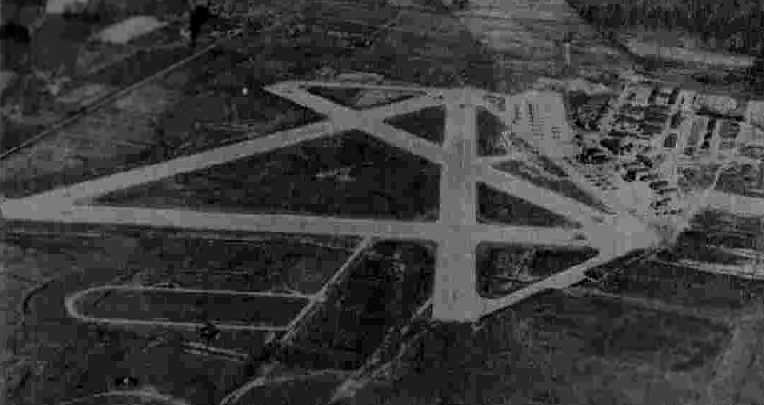Fentress was originally commissioned on 4/15/43 as one of several satellite airfields for Norfolk NAS. The base was primarily home to composite squadrons of FM Wildcats & TBM Avengers that would eventually serve on small CVE escort carriers. Fentress could accommodate up to 3 squadrons, typically composed of 9 Wildcats & 12 Avengers.
Several composite squadrons passed through Fentress in 1943. The base was designated as a night flying field in 1944, and Field Carrier Landing Practice night training commenced.
The base's complement peaked in 1944 with a total of 1,384 personnel. Aircraft assigned to Fentress included six SNJs, an NE Piper Cub, a PBY Catalina amphibian, and a GH Howard.
A new construction program was begun in 1944. Fentress temporarily closed for a month for the installation of runway lighting.

A 3/18/45 aerial view looking north at Fentress NAAS from the 1945 AAF Airfield Directory (courtesy of Scott Murdock) depicted the field as having 4 paved runways, with a large number of aircraft parked on the northeast ramp. The directory described Fentress as a 388 acre irregularly-shaped property within which were four 2,500' concrete runways. The field was said to have one wooden 111' x 58' hangars, to be owned by the U.S. Government & operated by the Navy.
By the end of WW2, the Fentress airfield consisted of four 2,500' concrete runways, along with numerous taxiways & large ramp areas. Fentress was placed in Caretaker status in 1946, and became an Outlying Landing Field for NAS Oceana.
According to Robert Crabtree, “When WWII was over all the buildings were locked & boarded up. They hired one local man as caretaker named McClanahan.”
According to Robert Crabtree, CWO Davidson was the first commander of NALF Fentress after it was reopened.
In the postwar period, with higher-performance aircraft starting to be operated from Oceana, with their attendant need for much longer runways, a modern 8,000' paved Runway 5/23 was built at Fentress at some point between 1946-51. Robert Crabtree served at Fentress starting in 1951. He recalled, “All furnishings, tools, pencils, some weapons & ammunition were uncovered when we moved in. I had purchased a commercial speed graphic camera & set up my own darkroom in one of the empty buildings. The Oceana Crash & Salvage Crew sent a crash crew to NALF Fentress on a daily basis to stand-by for carrier practice shortly after adding the 8,000' runway.
A short time later a crew of about 35 men were sent there full-time. Many of these people were Reservists & their talents varied making this crew most unique & interesting.” Robert continued, “Fentress was located deep in the Dismal Swamp. We were about 8 miles away from the one good bar there named Kay's Place that we all visited almost on a daily basis. The Navy allowed us to use a vehicle to make one run twice a day to the nearest bus stop. For convenience we stole a bus stop sign & installed it in front of the bar. Most of the time our vehicle of choice was our Navy ambulance.”

Robert Crabtree recalled, “Carrier practice was done with a Landing Signal Officer, Radioman with communication trailer & a couple of others to keep records. They would come down from Norfolk or Oceana & fly with 4 planes in carrier operational formation at a height of about 300 feet on base leg. They would hang the plane by the prop & drop on the cut. They would touch down & give her the gun & go around again in the same for hours.” Robert continued, “Some units would bring us donuts, we would furnish coffee and would watch the Arthur Godfrey show on TV. They would also come with their swim suits. There is a good sized lake across the road from the front entrance that was formed from fill they used when the 8,000' runway was built. It was one of the best fresh water swimming holes anywhere around. The store at the gate was owned by Mennonites.” Robert continued, “Oceana would send about 7 tractors & mowing machines down to mow our acres several times a year. We would have drag races on the airfield if they were left there over the weekend. Once 2 collided & a transfer case was busted. We paid a local old time Mennonite blacksmith big time to forge and weld the cast iron transfer case that was busted. We had plenty of Navy gray paint. No one ever knew what we had done.”
At some point after 1965, the original WW2-era runways at Fentress were abandoned, with the single postwar jet-capable runway being the only one still used.
Fentress is still in use as a satellite airfield for NAS Oceana today.
Scott Shea reported in 2006, “On Weekends, NALF Fentress is open for radio controlled aircraft modelers. Its one of the best R/C sites in the area; we use the taxiway as the runway. Occasionally, we get asked by the ABF's to cease operations because of inbound aircraft. They practice carrier landings just a few hundred feet in front of us! Its frustrating to have to stop flying for a while but at the same time, how many chances do you have to see F-14s & F/A-18s practice carrier landings that close!”
Even though Fentress was built as an "outlying" field, the rapidly growing suburbs of Virginia Beach have been expanding ever more closely to the field. This has resulted in considerable pressure by the local community on the Navy to cease operations at Fentress, replacing it with yet another outlying field, even further from the current suburban sprawl. It seems to matter not that those who complain about the jet noise over their newly built suburbs in fact chose to move next to an military airfield that was there before they were Your tax dollars at work.